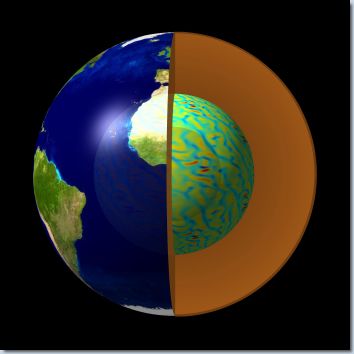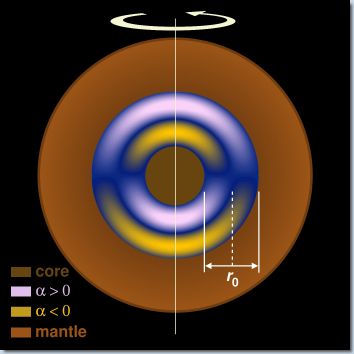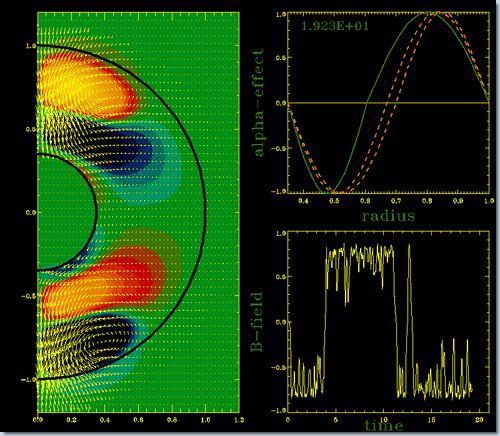Reversals of Earth's magnetic field
New model shows pole reversals like in the magnetic history of the Earth
A new approach to the understanding of the magnetic-field history of the Earth is found by numerical computer simulations. The magnetic field of our Planet is roughly shaped like the dipole from a bar magnet. At present, the magnetic north and south poles of the Earth are located near the geographic south and north poles, respectively. The polarity changes irregularly after 100000, maybe 1 million years. Even long periods with no changes are known. It takes only 10000 years for the reversal itself though. Scientists are seeking models being capable of explaining these sudden reversals. The new model is based on the simulation results of magnetoconvection at the Astrophysical Institute in Potsdam.

Reversal history of the magnetic field of the Earth. Time goes back in units of
million years; the two colours represent the two polarities of the field.
It has long been known that small-scale motions of a conducting fluid can have an amplifying effect on magnetic fields. An interior spherical shell of the Earth is fluid and - being made of iron - conducts electric currents. Internal heat sources let the fluid boil and produce complex up and down flows. This convection combined with the rotation of the planet leads to the self-sustained generation of magnetic field. The principle is called the α-effect.
Magnetoconvection simulations with NIRVANA revealed the existence of the α-effect and showed that it changes sign over radius (see results). If α is positive in the upper layer of the fluid shell, it is negative in the lower layer. Since the convective motions are a highly fluctuating, statistical process, the exact place where α changes sign varies with time. In a very small band of α-profiles the dynamo is oscillating, while it is steady for all other profiles. The right panel of the below figure shows the distribution of α.

Earth with interior convective shell. The innermost core is a solid iron ball. |

Vertical cut through the Earth. The α-effect resulting from simulations changes sign over radius, and has opposite sign in the two hemispheres. |
The idea is that the convection in the outer core very rarely leads to oscillations. The time spent in this regime is just enough to allow for a single reversal. This is simulated by a statistically fluctuating zero of the
α-effect in a full-sphere computation. The time evolution of such a dynamo exhibits irregular reversals indeed. The following film is part of such a simulation. The left panel shows the 'active' shell corresponding to the yellow-lilac area above, but now showing the strength of the magnetic field. The upper right panel gives the fluctuation of the α-distribution. The dashed lines indicate the very narrow channel in which oscillatory solutions can occur. The lower right panel measures the magnetic field at the north pole. The polarity is constant over long periods of time, but occasionally it is changed.

Dynamo simulation with magnetic-field reversals. MPEG (16MB)
The evolution of the magnetic field in the simulation bears an amazing resemblance to the magnetic history of the Earth revealed by palaeomagnetic measurements.
André Giesecke, Rainer Arlt & Günther Rüdiger
[MHD group] [AIP home page]
| 

 last change 2005 April 16, R. Arlt
last change 2005 April 16, R. Arlt


